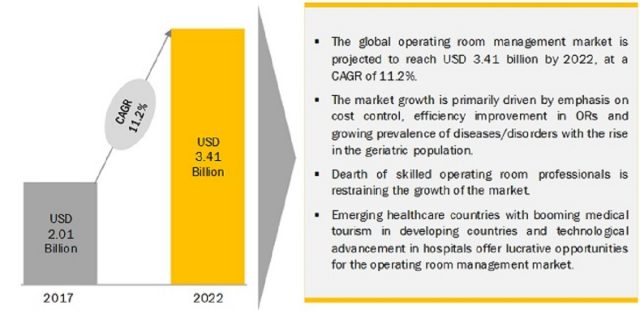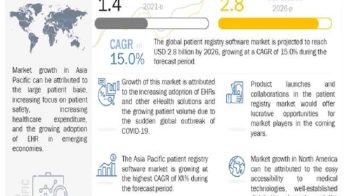
[145 Pages Report] Operating room management includes software solutions that enable the smooth running of operating rooms and improve the productivity, efficiency, and quality of operating rooms.
The global operating room management market is expected to reach USD 3.41 Billion by 2022 from USD 1.81 Billion in 2016, at a CAGR of 11.2% during forecast period (2017-2022).
Market Dynamics
Driver: Increasing demand for OR supply management software
Supply chain management has been known to play a significant role in cost savings in healthcare organizations. The OR accounts for approximately 40%-60% of the total supply costs in hospitals, with the average expenditure on surgical inventory going up to USD 1 million.
A lack of proper management of OR inventory supply makes it difficult to track the utilization of supply per case, which creates issues in reimbursement. As a result, reimbursement of surgeries was being declined due to an unavailability of records for surgical procedures and inventories utilized. Moreover, the possibility of surplus OR inventories leads to high and costly wastage. In such scenarios, the role of supply chain management software becomes critical. Supply chain management software enables the effective management of expensive OR materials (injectable, instruments), tracking surgical materials such as tissues, and maintaining an optimal supply as per the requirements of surgical units. Thus, the increasing cost of OR materials and decreasing reimbursement for surgeries has led to a need for controlling OR costs, ultimately adding to the demand for OR supply management software.
Download a PDF Brochure @ https://www.marketsandmarkets.com/pdfdownloadNew.asp?id=175407912
Restraint: High pricing and maintenance costs of ORM software
The adoption of ORM solutions has been particularly affected by their high installation and maintenance costs. ORM software will once installed also need to be regularly updated as per the user’s requirements and software enhancements, which again presents recurring expenditure. Additionally, the maintenance of high-end IT-enabled systems typically costs more than the software itself. Subsequently, it can be expected that the high costs incurred from the purchase, installation, maintenance, and upgrade of ORM software and solutions may negatively affect their overall adoption among end users, especially those facing financial constraints or under pressure to contain costs.
In 2017, North America is expected to account for the largest Operating Room Management Industry share, followed by Europe
Geographically, the global Operating Room Management Industry is segmented into North America, Europe, Asia Pacific (APAC), and the Rest of the World (RoW). In 2016, North America dominated the market, and this is primarily attributed to increasing hospital expenditure, rising focus on activities to create awareness about operating room management, and the large number of operating room procedures in this region. APAC is expected to witness the highest CAGR during the forecast period, owing to the increasing need to curb healthcare costs, investments & reforms to modernize the healthcare system, improving IT infrastructure are driving the growth of market in the region.
Request a Sample Pages @ https://www.marketsandmarkets.com/requestsampleNew.asp?id=175407912
Operating Room Management Industry Key Players
GE Healthcare (US), Becton, Dickinson and Company (US), McKesson Corporation (US), Cerner Corporation (US), Surgical Information Systems (US), Optum (US), MEDITECH (US), Picis Clinical Solutions (US), Getinge (Sweden), and STERIS (US)


